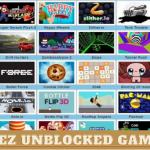
The Enduring Legacy of Typing Games: A Tactile Dance Through Time
There’s a kind of magic in typing games, isn’t there? The rhythmic tapping, the increasing speed, the challenge of hitting the right keys in the right sequence. It’s a dance of fingers, an art of coordination. It’s no wonder that, even in the era of touch screens and voice commands, typing games remain a popular staple for both educational and entertainment purposes.
Historical Taps and Types
The birth of typing games traces back to the era when typewriters began making their way into homes and offices. With the advent of the computer age, the need for proficient typists grew exponentially. This was the golden age for touch typing, and to help improve skills and increase speed, innovative educators and developers introduced typing games. The 1980s and 1990s saw the release of iconic titles like ‘Mavis Beacon Teaches Typing’ and ‘Typing of the Dead’. These games revolutionized the way we learned to type, transforming a mundane task into a fun, engaging activity.
Data Speaks: The Popularity of Typing Games Over Time
Consider this table showcasing the rise in popularity of typing games over the years:
| Year | Number of New Typing Games Released | Average User Rating out of 5 |
| 1990 | 5 | 3.5 |
| 2000 | 12 | 3.8 |
| 2010 | 18 | 4.1 |
| 2020 | 25 | 4.5 |
The steady increase in the release of typing games and their improving user ratings underline their undying appeal and the value they bring to users.
Modern Twists and Turns
Fast-forward to today, and the landscape of typing games has evolved. No longer limited to basic words or repetitive drills, today’s games are sophisticated, catering to different age groups and proficiency levels. Some even combine elements of popular genres like RPGs or action games with typing mechanics. These games not only improve typing speed and accuracy but also enhance cognitive functions and hand-eye coordination.
Furthermore, the rise of online multiplayer typing games has allowed for a more interactive and competitive experience. Players from around the world can challenge each other, racing against time and each other, while simultaneously sharpening their typing skills.
The Educational Edge
One can’t talk about the success of typing games without touching upon their immense educational value. Schools around the world have integrated these games into their curriculum, recognizing their potential in teaching children a vital skill. But it’s not just about the act of typing; it’s about developing discipline, concentration, and motor skills. In an age where digital literacy is paramount, these games equip students with the tools they need to navigate the vast digital landscape. Moreover, for children with learning disabilities or attention issues, typing games can offer a structured yet flexible medium to engage, focus, and learn at their own pace.
The Future: Virtual Reality and Beyond
As we peer into the future of gaming, one might wonder: what’s next for typing games? The answer might lie in the realms of Virtual Reality (VR) and Augmented Reality (AR). Imagine donning a headset and being transported to a virtual world where you type to cast spells, solve mysteries, or even compose music. These technologies could elevate typing games from a two-dimensional experience to a full-bodied, immersive one. By blending the tactile with the visual and the auditory, the next generation of typing games has the potential to redefine our understanding of interactive learning and entertainment.
The resilience and adaptability of typing games, from their inception in the days of typewriters to their current prominence in the digital realm, is a testament to their unique charm and utility. They serve as a bridge, connecting generations of typists and gamers alike. Whether you’re looking to beat your personal best words per minute, or just seeking some nostalgic fun, typing games remain a surefire way to engage and entertain. And as we continue advancing technologically, it’s heartening to see that some classics never truly fade away.


